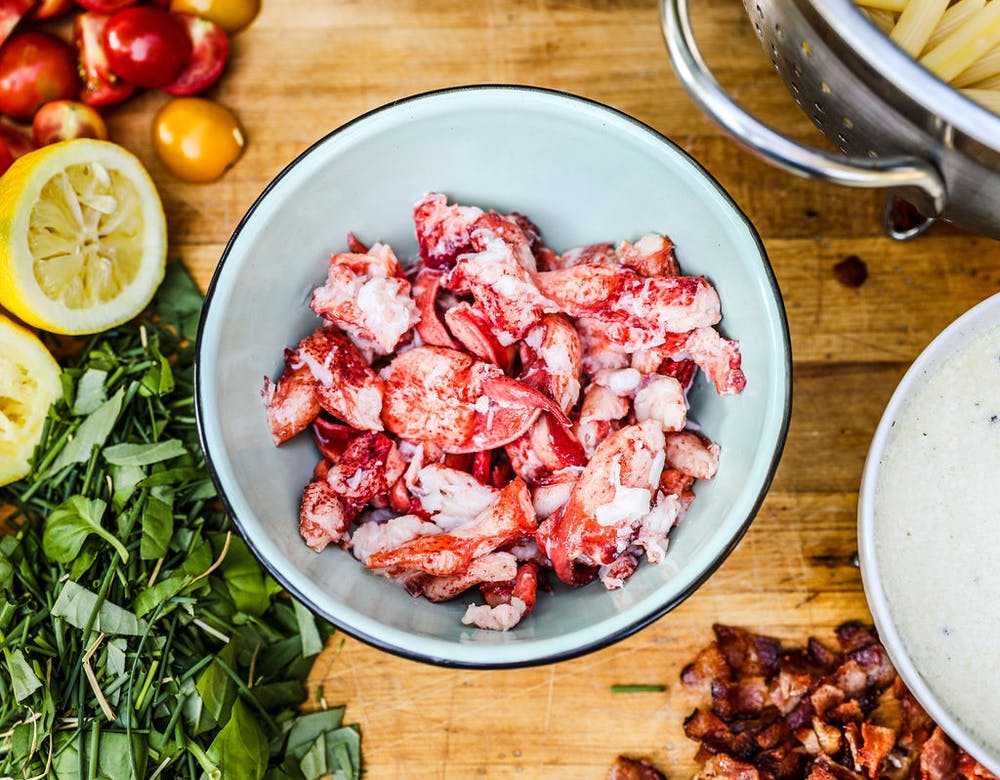Our sweet and buttery lobster is harvested sustainably in the cold waters of the Gulf of Maine by fishermen we know and trust. Strict regulations on size, trap and license limits, and regulations on egg-bearing females, ensure the fishery remains sustainable. Our lobster meat is flash-frozen in a liquid nitrogen tunnel. Freezing fast (our lobster meat goes from 40 degrees to negative 15 degrees in under 15 minutes) means the ice crystals that form in the tissue are microscopic, so they don't rupture the proteins in the lobster meat, and you get the highest quality frozen lobster meat.
You can enjoy our lobster near you in our shacks, or from your local grocer, and get lobster delivered direct to you from our Luke's Online Market.
Enjoy flash-frozen, Gulf of Maine lobster shipped anywhere in the US!
There is no shortage of ways to enjoy our favorite, versatile crustacean! From tails, to knuckle and claw meat, to whole live lobsters, it's perfect for celebratory meals, summer picnics, or even an easy weeknight meal. Check out some of our favorite ways to prepare lobster below:
Luke's Lobster Rolls
Grilled Lobster Tails
Lobster Carbonara
View All Lobster Recipes
STORAGE AND SHELF LIFE
When you receive your frozen lobster meat, store it in the freezer. When you are ready to eat them, thaw under refrigeration until fully thawed (approximately 16 to 24 hours) before preparing. For best quality consumer within 6 days of thawing.
When you receive your whole live lobster, you should refrigerate them immediately, and ideally cook the same day, but within 24 hours max. Check out our instructional video for How to Steam a Whole Lobster.
When you receive your frozen lobster tails, store in the freezer. When you are ready to eat them, thaw under refrigeration until fully thawed (approximately 16 to 24 hours) before preparing. For best quality consumer within 2 days of thawing.
All of our flash-frozen products will arrive frozen, shipped in our 100% recyclable shipping boxes, via UPS. For more information on shipping, visit our FAQ here.

SUSTAINABILITY
Maine’s lobster fishery is rightly hailed as being one of the most sustainable fisheries in the world. Maine was the first state to adopt regulations around lobster fishing. Those regulations include but aren't limited to:
- Maine has both minimum and maximum size restrictions for lobsters that can be caught.
- Lobstermen throw back female lobsters bearing eggs, and put a v-shaped notch in the lobster's tail. If that lobster is ever caught again without eggs, it cannot be kept, as it is marked as a fertile breeder.
- Lobster traps are required to have juvenile vents, so small lobsters can come and go to get their free lunch without risking becoming lunch themselves at the hands (claws) of a larger lobster.
- In Maine, there's a limited number of lobstering licenses given out to prevent overfishing, as well as a limited number of traps that are allowed to be set.
- The Maine fishery has an owner operator requirement, meaning that the fisherman who has the license is the only one who can fish his traps. In an age of consolidation, this individualistic owner-operator requirement has bucked the trend of corporate conglomerates, and has helped Maine fishing communities stay afloat economically.
- Maine’s lobster fishing industry is truly a small, owner-operator industry, one passed down through the generations and one that cannot be bought out. The individual responsibility that goes with the fishery and the pride in the fishery helps to ensure its sustainability - Maine’s fishermen seek to care for the fishery because it belongs to them and their families.
- Maine’s lobster fishery is rightly hailed as being one of the most sustainable fisheries in the world. Maine was the first state to adopt regulations around lobster fishing. Those regulations include but aren't limited to:
- Maine has both minimum and maximum size restrictions for lobsters that can be caught.
- Lobstermen throw back female lobsters bearing eggs, and put a v-shaped notch in the lobster's tail. If that lobster is ever caught again without eggs, it cannot be kept, as it is marked as a fertile breeder.
- Lobster traps are required to have juvenile vents, so small lobsters can come and go to get their free lunch without risking becoming lunch themselves at the hands (claws) of a larger lobster.
- In Maine, there's a limited number of lobstering licenses given out to prevent overfishing, as well as a limited number of traps that are allowed to be set.
The Maine fishery has an owner operator requirement, meaning that the fisherman who has the license is the only one who can fish his traps. In an age of consolidation, this individualistic owner-operator requirement has bucked the trend of corporate conglomerates, and has helped Maine fishing communities stay afloat economically.
Maine’s lobster fishing industry is truly a small, owner-operator industry, one passed down through the generations and one that cannot be bought out. The individual responsibility that goes with the fishery and the pride in the fishery helps to ensure its sustainability - Maine’s fishermen seek to care for the fishery because it belongs to them and their families.

ABOUT THE LOBSTER FISHERY
The lobster fishery is the largest fishery in Maine. The season runs year-round although peaks in the summer and fall. Licensed Maine lobstermen work all along the coast, catching lobsters in stationary traps or pots. As invertebrates, lobsters grow by molting, or shedding, their old shell and growing a new one to accommodate growth.
In the summer the lobster migrate into the protected waters of the shore to molt or shed their shell. If you spend any time on a fishing wharf you will hear the colloquial term “shedders” – these are the lobsters that have just migrated and shed their shell, and what Maine fishermen catch throughout the summer and fall months. The meat in “New Shells” (the official name for shedders) is more tender, and sweeter. Because of the seasonality of the Canadian lobster fishing season, Maine is basically the only place you can get new shell lobster. In the winter you won't see the same buoys dotting the shoreline because there aren't any lobsters inshore in the winter; winter lobstering happens offshore.
The Canadian lobster fishery is organized by Lobster Fishing Areas (LFAs). Each LFA has a start and stop date that dictates when fishing is allowed. The LFAs that we source from have an approximate season of May-late June. When we source Canadian lobster, we are sourcing from LFAs around beautiful Cape Breton and Quebec. Some of those harbors include; Port Hood, Mabou, Judique, Paspebiac, Gaspe, Port-Daniel, and Perce. In December, we occasionally source from ports around Southwest and East Coast Nova Scotia like Yarmouth, Clarks Harbour, Meteghan, Lunenburg, and Port Mouton.
INGREDIENTS AND NUTRITION
Lobster Ingredients: Lobster, Water, Salt.
Contains: Crustacean Shellfish (Lobster).
Lobster is high in a few key nutrients that make it extra-healthy.
- Phosphorous, necessary for forming teeth, bones, healthy joints, and supporting a healthy metabolism.
- Vitamin B12 for blood cell maintenance and prevention of neurological disorders
- Selenium, which is helpful to your immune system, metabolism, and prevention of heart disease
Order Lobster Now
<div class="dynamic-checkout__content" id="dynamic-checkout-cart" data-shopify="dynamic-checkout-cart"> <shopify-accelerated-checkout-cart wallet-configs="[{"name":"shop_pay","wallet_params":{"shopId":36382998667,"merchantName":" Luke's Lobster","personalized":true}},{"name":"amazon_pay","wallet_params":{"checkoutLanguage":"en_US","ledgerCurrency":"USD","placement":"Cart","sandbox":false,"merchantId":"A19HSX2W14S9VQ","productType":"PayAndShip","design":"C0002"}}]" access-token="7831df81aec7ebe10597f4893aa93bd4" buyer-country="US" buyer-locale="en" buyer-currency="USD" shop-id="36382998667" cart-id="46ea10e74400e63fcbf4f341bd628c6c" enabled-flags="["ae0f5bf6"]" > <div class="wallet-button-wrapper"> <ul class='wallet-cart-grid wallet-cart-grid--skeleton' role="list" data-shopify-buttoncontainer="true"> <li data-testid='grid-cell' class='wallet-cart-button-container'><div class='wallet-cart-button wallet-cart-button__skeleton' role='button' disabled aria-hidden='true'> </div></li><li data-testid='grid-cell' class='wallet-cart-button-container'><div class='wallet-cart-button wallet-cart-button__skeleton' role='button' disabled aria-hidden='true'> </div></li> </ul> </div> </shopify-accelerated-checkout-cart> <small id="shopify-buyer-consent" class="hidden" aria-hidden="true" data-consent-type="subscription"> One or more of the items in your cart is a recurring or deferred purchase. By continuing, I agree to the <span id="shopify-subscription-policy-button">cancellation policy</span> and authorize you to charge my payment method at the prices, frequency and dates listed on this page until my order is fulfilled or I cancel, if permitted. </small> </div>












